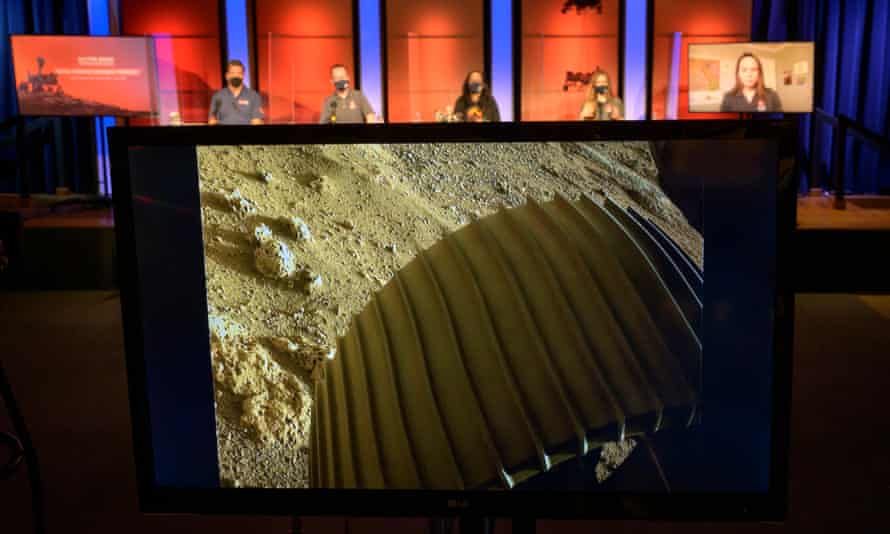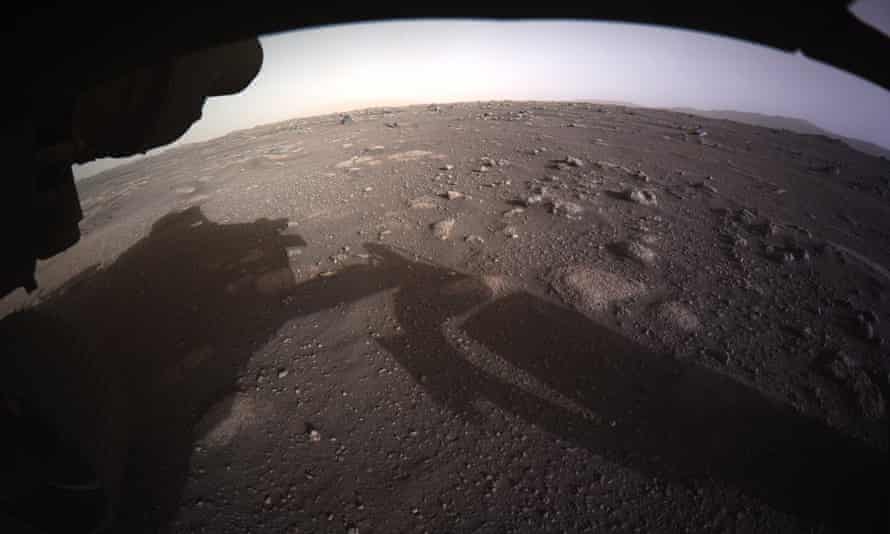Monitoring Desk
Car-sized vehicle designed to seek signs of life is pronounced ‘healthy’ after dramatic descent to surface of the red planet
Nasa scientists have said the Perseverance Mars rover is “healthy” and is beaming back many stunning new images from the surface of the planet, promising significant scientific discoveries ahead.
At a celebratory press conference on Friday, one day after the rover’s landing, Nasa shared new images, including the first color pictures beamed directly from Mars as opposed to images touched up later.
The rover documented its own touchdown via an ingenious system of booster rockets and a “sky crane”. It landed in a “pool-table flat” crater in a prime location for searching for traces of ancient life, scientists said.
“I can definitely say that when we saw this image, seeing the rover hanging underneath the sky crane … it was stunning, and the team was awestruck, and there was just a feeling of victory,” said Pauline Hwang, surface mission operations systems (MOS) manager.
Hwang said the team “went wild” when they saw the first images. “The team just went crazy for … we were just kind of like on cloud nine … weird, dreamlike state.
“Just the clarity, and just the reality of it, it was just unbelievable.”
Nasa’s mission to search for ancient signs of life received a huge boost on Thursday after the successful landing on Mars of the Perseverance rover, the most sophisticated robotic geologist ever created.
The rover’s broad mission is to stay on Mars for a couple of years, gather data and harvest samples to be collected and returned to Earth on a future mission. The point is to determine whether there was life on Mars and answer subsidiary questions.
The wheeled rover could begin to move around its new home as early as late February, and its mini-helicopter could launch as early as April, the team said on Friday.

The space agency’s ninth mission to the cold, dry, red planet was steered by a $2.7bn (£2.1bn), car-sized, six-wheeled rover, Perseverance, that streaked across the unforgiving Martian atmosphere to make its intense descent and landing. The final phase, following a 203-day journey, was described “seven minutes of terror” by engineers.
“Touchdown confirmed! Perseverance safely on the surface of Mars, ready to begin seeking signs of past life,” the flight controller, Swati Mohan, announced at mission control on Thursday to back-slapping, fist-bumping colleagues wearing masks against the coronavirus.
Perseverance – fondly known as Percy – landed with “eyes open” taking images of the surface to choose its landing spot. Weighing more than a tonne, it landed nearly in the middle of the landing zone within the 28 mile-wide (45km) Jezero crater north of the planet’s equator.
The site was chosen for its promise of preserving signs of life: it was once home to an ancient lake and river delta that may have collected and buried microbes and locked them within rocks.
A second round of applause erupted in the control room as the first images of the surface arrived minutes after touchdown. Partially obscured by a dust cover, the first picture was a view from one of Percy’s hazard cameras. It showed the flat, rocky surface of the Jezero crater. A second image showed a view from behind the rover of the Jezero crater.
More than half of the spacecraft sent to Mars have blown up or crashed because of hardware or software mishaps. Nasa’s new generation of rovers, including Perseverance, relied on a rocket platform called a sky crane to lower it on to the Martian surface.

Previous Mars missions, including Curiosity and Opportunity, have suggested Mars was once a wet planet with an environment likely to have been supportive of life billions of years ago. Astrobiologists hope this latest mission can offer some evidence to prove whether that was the case.
“It’s hard to find questions bigger than this … we’re asking the question ‘are we alone?’” Ken Williford, deputy project scientist for the mission, told CNN. “Here we are at the beginning of a mission that really for the first time – in a very long time – is tasked very directly with seeking signs of ancient life. We want to know are we alone here on Earth in a cold, dark universe or is life common, does it arise whenever the conditions are right?”
Perseverance – brandishing the most cameras ever sent to Mars and two microphones that will allow us for the first time to hear the sounds of the planet – is carrying a clutch of sophisticated instruments designed to analyse rocks for biosignatures, or the chemical hallmarks of life.
It will also store samples from the planet’s surface – future missions backed by Europe and the US are expected to retrieve these samples and return them to Earth.
Attached to the rover’s belly is a diminutive helicopter called Ingenuity. The 1.8kg drone-like rotorcraft is the first flying machine ever sent to another planet and could serve as a “pathfinder” to discover inaccessible areas or as a scout for future rovers.
Apart from Nasa, missions from the UAE and China to Mars also kicked off last year. In 2023, the European Space Agency is expected to land its Rosalind Franklin rover, which will carry a drill capable of reaching metres below the surface, where biomolecules may survive protected from the harsh conditions above.
Courtesy: The Guardian






